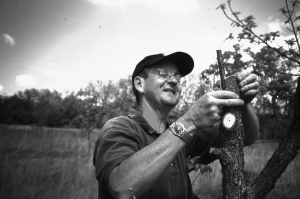Several Missouri black walnut and pecan growers have found another crop in their plantations in recent years. With the steadily increasing demand for grafted nut trees, nurseries need a supply of grafting wood from improved varieties. That wood, called scionwood, can only be supplied from established nut orchards with trees grafted to those improved nut cultivars.
In February and early March the scionwood is collected by cutting only the previous year's growth from tree branches. This one-year-old growth is the most likely to grow when grafted onto an understock (existing tree). The understock is cut off at about waist height and the new wood is attached, making sure the cambium layers of both pieces are in solid contact. These grafts usually are made around the first week of May for best success.
Scionwood may be available through members of the Missouri Nut Growers Association. The organization also offers grafting instruction at their annual spring meeting which will be held on May 5. The Grafting Day will be held on the Wayne Adams Farm located 10 miles north of Joplin on Highway 43. Contact Mary Ann Byrd at (660) 925-3253 for more information.
 |  |
| A piece of scionwood from an improved black walnut is placed on a native walnut tree by Mark Coggeshall, tree improvement specialist at the University of Missouri Center for Agroforestry. | Completed graft is dressed in a plastic baggie after the scionwood and its cambium layer is exactly matched to the cambium of the understock, so the two layers can weld through cell growth. |